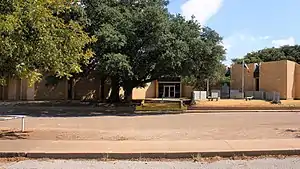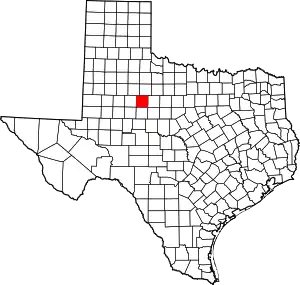Fisher County, Texas
Fisher County is a county located in the U.S. state of Texas. As of the 2010 census, its population was 3,974.[1] The county seat is Roby.[2] The county was created in 1876 and later organized in 1886.[3] It is named for Samuel Rhoads Fisher,[4] a signer of the Texas Declaration of Independence and a Secretary of the Navy of the Republic of Texas. Fisher County was one of 30[5] prohibition, or entirely dry, counties in Texas, but is now a fully wet county.
Fisher County | |
|---|---|
 The Fisher County Courthouse | |
 Location within the U.S. state of Texas | |
 Texas's location within the U.S. | |
| Coordinates: 32°44′N 100°24′W | |
| Country | |
| State | |
| Founded | 1886 |
| Named for | Samuel Rhoads Fisher |
| Seat | Roby |
| Largest city | Rotan |
| Area | |
| • Total | 902 sq mi (2,340 km2) |
| • Land | 899 sq mi (2,330 km2) |
| • Water | 2.8 sq mi (7 km2) 0.3%% |
| Population (2010) | |
| • Total | 3,974 |
| • Density | 4.4/sq mi (1.7/km2) |
| Time zone | UTC−6 (Central) |
| • Summer (DST) | UTC−5 (CDT) |
| Congressional district | 19th |
| Website | www |
Republican Drew Springer, Jr., a businessman from Muenster in Cooke County, has since January 2013 represented Fisher County in the Texas House of Representatives.[6]
From 1921 to 1925, the Democrat Richard M. Chitwood of Sweetwater represented Fisher County in the state House. He left his post to become the first business manager of Texas Tech University, but died the next year.[7]
History
- 10000 BC - Paleo-Indians were the first inhabitants. Later Native American inhabitants include the Pawnee, Wichita and Waco, Lipan Apache, Kiowa, and Comanche.[8]
- 1876 - The Texas legislature formed Fisher County from Bexar districts. The new county was named after Samuel Rhoads Fisher.[8]
- 1880 - The census reported 136 inhabitants.[8]
- 1881 - The Texas and Pacific Railway routed an east–west branch through Eskota.[9]
- 1885 - The town of Fisher was registered. Swedish immigrants founded the community of Swedonia.[10]
- 1886 - The town of North Roby was registered. Roby eventually won the county seat election over Fisher, but one of the voters, a Mr. Bill Purp, was later discovered to have been actually a dog whose owner lived near Roby.[11]
- 1920 - Fisher County was among Texas leaders in wheat production.[8]
- 1926 - Cotton became king, as 48,000 bales were ginned in the county.[8]
- 1928 - Oil was discovered in the county.[8]
- 1970 - The county's average annual farm income was evenly divided between livestock and crops.[8]
Geography
According to the U.S. Census Bureau, the county has a total area of 902 square miles (2,340 km2), of which 899 square miles (2,330 km2) are land and 2.8 square miles (7.3 km2) (0.3%) is covered by water.[12]
Major highways
 U.S. Highway 180
U.S. Highway 180 State Highway 70
State Highway 70 State Highway 92
State Highway 92
Adjacent counties
- Stonewall County (north)
- Jones County (east)
- Nolan County (south)
- Scurry County (west)
- Kent County (northwest)
- Taylor County (southeast)
Demographics
| Historical population | |||
|---|---|---|---|
| Census | Pop. | %± | |
| 1880 | 136 | — | |
| 1890 | 2,996 | 2,102.9% | |
| 1900 | 2,708 | −9.6% | |
| 1910 | 12,596 | 365.1% | |
| 1920 | 11,009 | −12.6% | |
| 1930 | 13,563 | 23.2% | |
| 1940 | 12,932 | −4.7% | |
| 1950 | 11,023 | −14.8% | |
| 1960 | 7,865 | −28.6% | |
| 1970 | 6,344 | −19.3% | |
| 1980 | 5,891 | −7.1% | |
| 1990 | 4,842 | −17.8% | |
| 2000 | 4,344 | −10.3% | |
| 2010 | 3,974 | −8.5% | |
| 2019 (est.) | 3,830 | [13] | −3.6% |
| U.S. Decennial Census[14] 1850–2010[15] 2010–2014[1] | |||
As of the census[16] of 2000, 4,344 people, 1,785 households, and 1,244 families resided in the county. The population density was five people per square mile (2/km2). The 2,277 housing units averaged two per square mile (1/km2). The racial makeup of the county was 83.75% White, 2.76% Black or African American, 0.37% Native American, 0.14% Asian, 11.58% from other races, and 1.40% from two or more races. About 21.36% of the population were Hispanic or Latino of any race.
Of the 1,785 households, 27.60% had children under the age of 18 living with them, 58.90% were married couples living together, 8.10% had a female householder with no husband present, and 30.30% were not families. About 28.30% of all households were made up of individuals, and 17.80% had someone living alone who was 65 years of age or older. The average household size was 2.39 and the average family size was 2.93.
In the county, the population was distributed as 23.90% under the age of 18, 6.30% from 18 to 24, 23.00% from 25 to 44, 24.10% from 45 to 64, and 22.70% who were 65 years of age or older. The median age was 43 years. For every 100 females, there were 92.90 males. For every 100 females age 18 and over, there were 89.80 males.
The median income for a household in the county was $27,659, and for a family was $34,907. Males had a median income of $25,071 versus $20,536 for females. The per capita income for the county was $15,120. About 13.50% of families and 17.50% of the population were below the poverty line, including 27.40% of those under age 18 and 10.50% of those age 65 or over.
Communities
Cities
- Hamlin (mostly in Jones County)
- Roby (county seat)
- Rotan
Unincorporated communities
Ghost Towns
Politics
| Year | Republican | Democratic | Third parties |
|---|---|---|---|
| 2020 | 79.3% 1,448 | 19.3% 352 | 1.4% 26 |
| 2016 | 73.2% 1,265 | 23.3% 403 | 3.5% 61 |
| 2012 | 67.2% 1,094 | 31.4% 512 | 1.4% 23 |
| 2008 | 60.7% 1,083 | 38.5% 687 | 0.8% 14 |
| 2004 | 60.4% 1,161 | 39.4% 758 | 0.2% 4 |
| 2000 | 51.7% 968 | 47.2% 884 | 1.1% 20 |
| 1996 | 29.0% 537 | 61.8% 1,142 | 9.2% 170 |
| 1992 | 24.2% 539 | 55.8% 1,242 | 20.0% 444 |
| 1988 | 32.2% 721 | 67.7% 1,516 | 0.1% 3 |
| 1984 | 40.9% 965 | 58.7% 1,384 | 0.3% 8 |
| 1980 | 34.4% 838 | 64.2% 1,564 | 1.4% 35 |
| 1976 | 22.2% 573 | 77.4% 1,993 | 0.4% 10 |
| 1972 | 56.2% 1,207 | 43.5% 933 | 0.3% 7 |
| 1968 | 23.3% 555 | 65.4% 1,560 | 11.3% 270 |
| 1964 | 17.7% 454 | 82.1% 2,108 | 0.2% 5 |
| 1960 | 25.6% 679 | 74.1% 1,966 | 0.4% 10 |
| 1956 | 28.7% 673 | 71.0% 1,664 | 0.3% 6 |
| 1952 | 40.4% 952 | 59.6% 1,405 | 0.1% 2 |
| 1948 | 6.5% 149 | 90.3% 2,063 | 3.2% 73 |
| 1944 | 6.6% 154 | 87.5% 2,041 | 5.9% 137 |
| 1940 | 8.1% 199 | 91.6% 2,260 | 0.3% 8 |
| 1936 | 7.0% 155 | 92.8% 2,068 | 0.3% 6 |
| 1932 | 7.0% 105 | 92.6% 1,395 | 0.4% 6 |
| 1928 | 60.1% 1,259 | 39.9% 837 | |
| 1924 | 15.0% 302 | 82.1% 1,653 | 2.9% 58 |
| 1920 | 15.3% 152 | 74.8% 743 | 10.0% 99 |
| 1916 | 3.7% 46 | 77.2% 950 | 19.1% 235 |
| 1912 | 3.5% 21 | 94.7% 572 | 1.8% 11 |
See also
References
- "State & County QuickFacts". United States Census Bureau. Archived from the original on October 18, 2011. Retrieved December 16, 2013.
- "Find a County". National Association of Counties. Archived from the original on May 31, 2011. Retrieved 2011-06-07.
- "Texas: Individual County Chronologies". Texas Atlas of Historical County Boundaries. The Newberry Library. 2008. Retrieved May 23, 2015.
- Gannett, Henry (1905). The Origin of Certain Place Names in the United States. Govt. Print. Off. pp. 126.
- "Wet/Dry Status of Texas Counties as of November 2010". Texas Alcoholic Beverage Commission. Retrieved July 29, 2018.
- "State Rep. Springer announces district tour July 30". Lubbock Avalanche-Journal, July 16, 2013. Retrieved July 18, 2013.
- "Richard M. Chitwood". Texas Legislative Reference Library. Retrieved July 31, 2015.
- Shelton, Hooper. "Fisher County, Texas". Handbook of Texas Online. Texas State Historical Association. Retrieved 16 December 2010.
- "Eskota, Texas". Texas Escapes. exas Escapes - Blueprints For Travel, LLC. Retrieved 16 December 2010.
- "Swedonia, Texas". Texas Escapes. Texas Escapes - Blueprints For Travel, LLC. Retrieved 16 December 2010.
- "Roby, Texas". Texas Escapes. Texas Escapes - Blueprints For Travel, LLC. Retrieved 16 December 2010.
- "2010 Census Gazetteer Files". United States Census Bureau. August 22, 2012. Retrieved April 26, 2015.
- "Population and Housing Unit Estimates". United States Census Bureau. May 24, 2020. Retrieved May 27, 2020.
- "U.S. Decennial Census". United States Census Bureau. Retrieved April 26, 2015.
- "Texas Almanac: Population History of Counties from 1850–2010" (PDF). Texas Almanac. Retrieved April 26, 2015.
- "U.S. Census website". United States Census Bureau. Retrieved 2011-05-14.
- "Longworth, Texas". Texas Almanac. Texas State Historical Association. Retrieved 2018-11-17.
- Brunson, Doyle (1978). Doyle Brunson's Super System. Las Vegas, Nevada: Cardoza Publishing. ISBN 9781580424752. Retrieved 4 September 2017.
- Leip, David. "Dave Leip's Atlas of U.S. Presidential Elections". uselectionatlas.org. Retrieved 2018-07-22.
